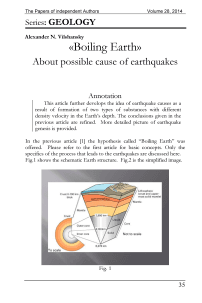«Boiling Earth». About possible cause of earthquakes
Автор: Alexander N. Vilshansky
Журнал: Доклады независимых авторов @dna-izdatelstwo
Рубрика: Geology
Статья в выпуске: 28, 2014 года.
Бесплатный доступ
This article further develops the idea of earthquake causes as a result of formation of two types of substances with different density velocity in the Earth’s depth. The conclusions given in the previous article are refined. More detailed picture of earthquake genesis is provided.
Короткий адрес: https://sciup.org/148311837
IDR: 148311837
Текст научной статьи «Boiling Earth». About possible cause of earthquakes
«Boiling Earth»
About possible cause of earthquakes
Annotation
This article further develops the idea of earthquake causes as a result of formation of two types of substances with different density velocity in the Earth’s depth. The conclusions given in the previous article are refined. More detailed picture of earthquake genesis is provided.
In the previous article [1] the hypothesis called “Boiling Earth” was offered. Please refer to the first article for basic concepts. Only the specifics of the process that leads to the earthquakes are discussed here. Fig.1 shows the schematic Earth structure. Fig.2 is the simplified image.
Fig. 1
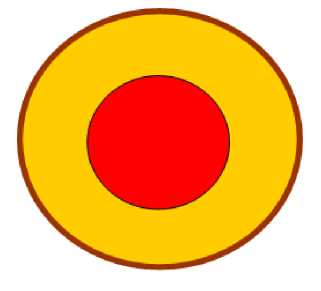
Fig. 2
We may think of the Earth as a gigantic spheric bowl filled mostly with the asthenospheric substance. This bowl is heated from inside by high temperature “oven”-the core. The bowl is covered with the spherical “lid”, the lithosphere.
Inevitably, in such a system, structures of at least two types should originate on the border of the core and asthenosphere (We’ll briefly call them 'bubbles' for future reference).
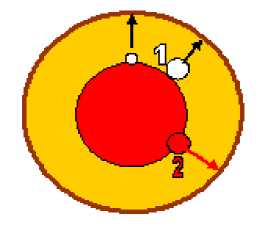
Fig. 3
Gaseous bubbles that originate in the proximity to the earth surface are shown here as whitecircles (type 1). Such bubbles gradually grow in size. At a certain point the buoyant (Archimedes’) force becomes greater than gravity. The bubble detaches from the nucleus and starts its movement towards the Earth surface. (Fig 3)
However, it is also possible that inside the nucleus there are processes that result in release of considerable amount of nucleus substance. We shall call them 'drops' for brevity, because these are not gaseous bubbles, but rather masses of quite solid substance of which the nucleus consists. Such 'drop' does not necessary have a spherical shape.
Both types of formations move from nucleus towards lithosphere. However the causes for the movement are different. Gaseous bubble rises by the buoyant force, as less dense body. The object of the second type, the 'drop' , although having very high temperature, does not float to the surface, but is rather cast by the centrifugal force from the center of the Earth to its periphery.
The speed of these formations may not be constant. It can reach 10-20 km/hr in the asthenosphere. Thus, the entire distance from the nucleus to the crust can be covered by bubbles and drops in 20-30 hours or up to several days, depending on its original state.
In the final point of its movement, the bubble creates a pressure on the bottom layers of the lithosphere. This pressure depends upon the size of the bubble. The size of the bubble can reach dozens of kilometers or more. The smaller bubbles cause smaller tensions. These tensions may accumulate or dissipate. Big bubbles may cause the cracking of the crust and earthquakes. The bubble kind of tries to 'break' the crust from the inside. Near the edges of the tectonic plates this can happen easier. This is the reason why earthquakes’ epicenters are located near these borders.
It was observed that big earthquakes happen more often in the times of 'sun tides'. In these cases, the earthquake epicenter is located at the minimum or at the maximum distance from the Sun. The bubble pushes the lithosphere surface up; at the same time this surface tends to move away from the earth center. The Moon gravity also contributes to these processes. However, the influence of the Sun and the Moon are the secondary factors. The main action is created by the bubble itself. This is probably why no direct connection between the position of the Earth, the Sun, the Moon and the peak earthquake probability was established. The bubbles also create additional pressure on the magmatic layers that may cause the lava eruptions. The volcano awakening and eruption may be a result of 'bubbles' or 'drops'. The earthquake in this case is not a result and not a cause, it is a concurrent event.
The specifics of bubble movements.
The rise of bubbles to the surface has its specifics. Had the Earth not spin, the bubble (white circle on fig.4) would move along the Earth radius from the detachment point near the nucleus towards the surface directly (dashed line arrow on Fig. 4). But due to the Earth sniping, an observer on the equator (point 'A') has a linear circular speed about 500 m/s. The
When the bubble moves towards the lithosphere, it passes the asthenosphere layers which move with the same angular speeds but with different linear speeds. (blue arrows on fig. 4)
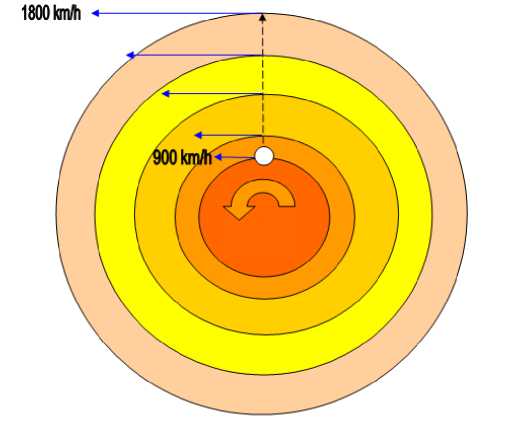
Fig. 4
While moving in tangent direction the bubble gets an acceleration entering every next upper layer of the asthenosphere. As a result, the bubble moves over a curve (Fig. 5).
The shape of this curve depends on the size and density (mass) of the bubble. Less dense and massive bubbles accelerate more. More dense and massive bubbles accelerate less. But in any case, the object that rises towards the lithosphere falls behind the movement of asthenosphere layers. The denser is the bubble, the more the lag is. This is shown on the Fig.5 as white circles “1” (gaseous bubbles) and red circles “2” (the ‘drops’).
In any case, for the observer on the Earth's surface, the bubbles should move from East to West.
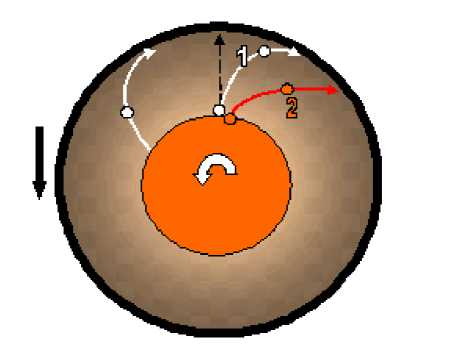
Fig 5.
The movement of gaseous bubbles was discussed in detail in the previous article [1]. As for the formations such as 'drops' type, we can assume that they make rather 'striking' effect than 'heaving' action. This can explain the occurrence of the foreshocks when the earthquakes are caused by bubbles, and the absence of foreshocks (sudden shock) as the effect of dense formations ('drops’). The second and the third sudden shocks may be a result of several 'drops', bursting into the asthenosphere out from the core. During their movement through the asthenosphere, 'the drops' perhaps do not change their shape and do not fall into parts.
The core surface is not isothermic. The core temperature is different in different places. The activity of bubble formation may be related to differences of temperatures in different points of the core. Also, the core shape is not exactly spheric. This was recently shown with the help of satellite surveying. This explains inconsistency in the location of seismic zones on the Earth surface (Fig. 6).
It should be also noted that because of the different density of 'bubbles' and 'drops', the gravimeter will show the decrease of gravity for ‘bubbles’ and an increase in gravity for ‘drops’.
The so-called ”long period oscillations” (fig.7) may be the result of processes described here.
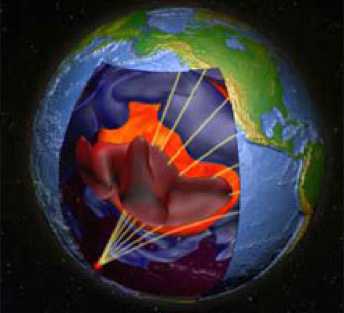
Fig. 6
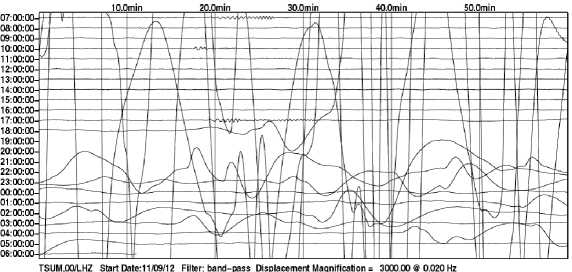
Fig 7. Namibia (09 Nov. 2012) (The data was obtained by Dr. Razgon)
The fact that the bubbles and drops develop only in the certain areas of the core gives an additional opportunity to predict the earthquakes. To do so, the monitoring stations with the equipment for bubble detection should be placed along the typical bubble paths. This equipment should include gravimeters that are capable to indicate the passing of bubbles and drops to the depth of 100-150 km. This is entirely possible with today's technology. Based on how fast the formations approach the Earth surface and their direction, the probable future earthquake place can be predicted. In this case the local stations described in the article [1] would monitor the changing situation better.
The last nail into the coffin of the theory of tectonic plates cracking as the main cause of the earthquakes is driven by newly appearing crack of the African tectonic plate in the middle of Africa. This event is not accompanied by seismic activity, although the crack is growing literally “in front of our eyes”.
All the above doesn't mean that the movement of the tectonic plates does not affect the earthquakes origination.
The plates’ movement also can be a cause, but it is hardly predicable. At the other hand the bubble can be detected well in advance.

